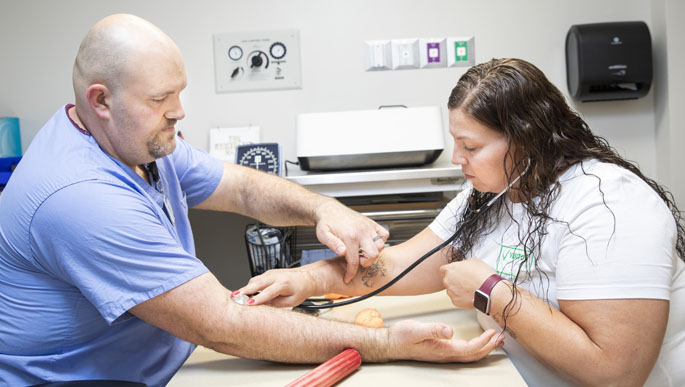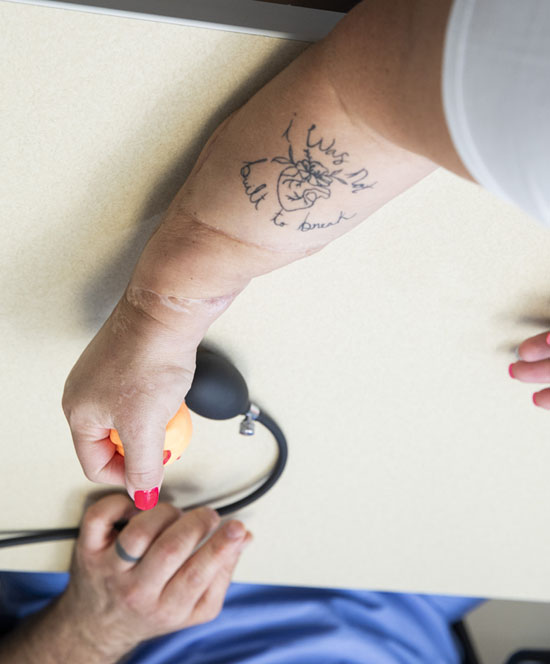
Forty-year-old Dawn Reed carefully places a blood pressure cuff around the arm of Vanderbilt University Medical Center occupational therapist Justin Stehr, OTR, CHT, and deftly squeezes the bulb to inflate the cuff.
Across her right forearm is a tattoo that reads in her own shaky cursive, “I was not built to break.” To Reed, and those who know about her recovery from a massive injury to this arm, these words are fitting.
Over the span of more than a year, hundreds of providers from Emergency Medicine, Trauma, Orthopaedic Surgery, Plastic Surgery and Occupational Therapy have played a role in saving and restoring the function of Reed’s right arm and hand after a utility terrain vehicle (UTV) accident in July 2022. Many who assisted in her healing and rehabilitation call her recovery nothing short of miraculous.
Reed laughs when she says she still doesn’t have much feeling in her right pinky and ring finger. She knows that without the dedication and skills of those at VUMC, she likely wouldn’t have a right hand at all, and not much of an arm.
Today, Reed is steadily checking off a list of accomplishments using her right hand and arm: signing her name, brushing her teeth, and pulling items from the refrigerator. And she’s regaining skills she’ll need to return to her career as a medical assistant. It’s taken a dozen surgeries, weekly occupational therapy sessions, and a mountain of personal grit to reach this point.
At the time of the accident Reed lived in Michigan and was visiting friends in rural Franklin County, Tennessee. The group decided to take a late-night, off-road ride. Reed was a passenger when her UTV’s driver made a sharp turn to execute a donut. She instinctively reached for the vehicle’s roll cage just before it flipped.
“I remember waking up with blood gushing, and my arm trapped under the roll cage,” she said. “I panicked and started flailing around. Once the dust clouds settled, the guys realized what had happened and were able to lift the vehicle off my arm.”
They rode out to the nearest roadway to meet an ambulance. Reed’s mangled arm was bound tightly in shirts, and she clutched several bone fragments in her left hand. She was transported by a LifeFlight helicopter to the VUMC Emergency Department trauma bay. As gravel and dirt were flushed away, the ED team assessed her catastrophic injuries.

Every structure of her arm – bone, skin, ligaments, muscles, tendons and nerves – was damaged. Reed’s arm had been “degloved,” meaning the top layers of skin and tissue were torn away from underlying muscle, connective tissue and bone. Her radius and ulna bones were crushed, with one-third of her ulna missing or in splinters.
Orthopaedic Hand and Upper Extremity surgeon Mihir Desai, MD, was on call when Reed arrived. He and his team began a four-hour surgery to reconnect viable internal structures to give her arm the best chance at restored blood flow and nerve regeneration. A metal plate was added to replace missing bone. The arm’s remaining skin was stitched together, and broad-spectrum antibiotics were administered to ward off infection.
After surgery, Reed wanted to return home to Michigan. The stipulation was that she immediately connect with specialists there to manage the ongoing intensive care and rehabilitation of her arm.
In Michigan, after an exploratory surgery to remove skin that had begun dying, an orthopaedic surgeon, and a plastic surgeon agreed: She needed an immediate transfer to University of Michigan Medical Center, where her arm would likely be amputated.
“My boyfriend told me, ‘You just need to go back down to Vanderbilt. They’re the ones that saved your arm,’” Reed said. “My family agreed.”
The orthopaedic surgeon in Michigan contacted Desai to advise him Reed was heading back to VUMC. Desai felt she needed a “free flap” surgery if there was any chance to save her arm. He pulled in two experts from VUMC’s Department of Plastic Surgery, Brian Drolet, MD, chief of Hand and Upper Extremity Surgery, and Brad Hill, MD, director of Limb Reconstruction. VUMC’s plastic surgeons are experts in free flap procedures to help manage large wounds.
Reed, her mother and her then 13-year-old daughter, Aria, whom she credits for providing unfailing support, made the more than seven-hour drive back to Nashville. Reed said her arm looked like something out of “a crazy horror movie.”
“I vividly remember meeting her in the OR holding room,” said Drolet. “We were looking at a large soft tissue defect, with exposed bone and hardware. We knew immediately this was going to be big problem to tackle.
“I told her we had some big decisions to make, and a long road in front of us to regain use of her hand. Dawn said, ‘I want to do anything I can to save my arm and hand.’ I told her, ‘Tonight, we’re going to clean things up and get started making a plan to do exactly that.’”
For Reed’s next major surgery, Drolet was joined by Galen Perdikis, MD, chair of the Department of Plastic Surgery. For the free flap procedure, the surgeons transferred a section of skin and tissue from her thigh to her arm to replace the failing tissue. The procedure involves delicate microsurgery to reconnect arteries, which bring blood into the flap, and veins, which allow blood to flow out. The surgeons also replaced the metal hardware to join Reed’s bones together.
“After surgery, Dawn went to the Surgical ICU where they checked on that flap every hour with a Doppler to monitor for blood flow,” Drolet said. “There is high intensity post-op care.”
Soon after she was discharged, Reed began working with Stehr, an occupational therapist in the Department of Plastic Surgery with special training in trauma, wound care and therapy specific to hands and arms. By sharing the same space as surgeons, more collaboration and check-ins are possible when patients come in for therapy appointments.
Reed began seeing Stehr twice a week, where she focused on relearning tasks she needed for her job as a medical assistant. Smaller, incremental surgeries took place throughout the next year with Drolet and other members of the Plastic Surgery team to further improve the function and range of motion of her arm and hand.
“Pretty soon, I moved down here because Vanderbilt has been fantastic,” Reed said. “Everybody that played the role in saving my arm and helping me recover has been just amazing.”
Stehr used ultrasound therapy to help decrease swelling and inflammation and constructed numerous custom braces to support proper healing and function. With injuries of Reed’s magnitude, rehabilitation often focuses on regaining enough use so the limb can assist in basic holding or in stabilizing objects, but she continued to defy the odds.
“Our goal was always how do we get her as much range of motion and as healed and as strong as she could be so that when that next surgery happens, she would have as good of a chance as possible for success,” Stehr said.
“There were always little micro challenges, like not being able to get the range of motion we were aiming for. In terms of big challenges, it was mainly just trying to get her functional. We knew we wouldn’t get her back to the point where she was pre-injury before she had to return to work and to a more normal life. We were always trouble shooting, week by week.”
Stehr credits Reed for her amazing rehabilitation. She went to the gym and worked on exercises to strengthen her arm and hand and didn’t let small setbacks derail her progress.
“One week she said, ‘I really want to be able to write my name,’” Stehr said. “So, we worked on that. She showed up the next week and said, “Guess what, I wrote my name!”
“She now has an arm and hand that work very well. She has great strength, and she’s going to have even better strength and mobility. For me, this shows the value of patient-driven care, where the patient is highly involved and has taken something that would have been catastrophic and steadily progressed to the point that she will have pretty darn good use of her arm overall.”
Hill, who directs Limb Reconstruction for the Department of Plastic Surgery, assessed Reed during one of her therapy appointments and gave her welcome news.
“He told me I have more function with my hand and arm now than I would have with any kind of prosthetic I might have gotten,” Reed said. “If it wasn’t for Vanderbilt, I don’t honestly think I would have a right hand right now.
“There were times when Dr. Drolet would tell me, ‘You’re not out of the woods yet. You could potentially still lose this arm,’ she remembered. “I told him, ‘Uh-uh, you’re not taking my arm from me. It might not look pretty because of all the scars, but it’s mine!’”















